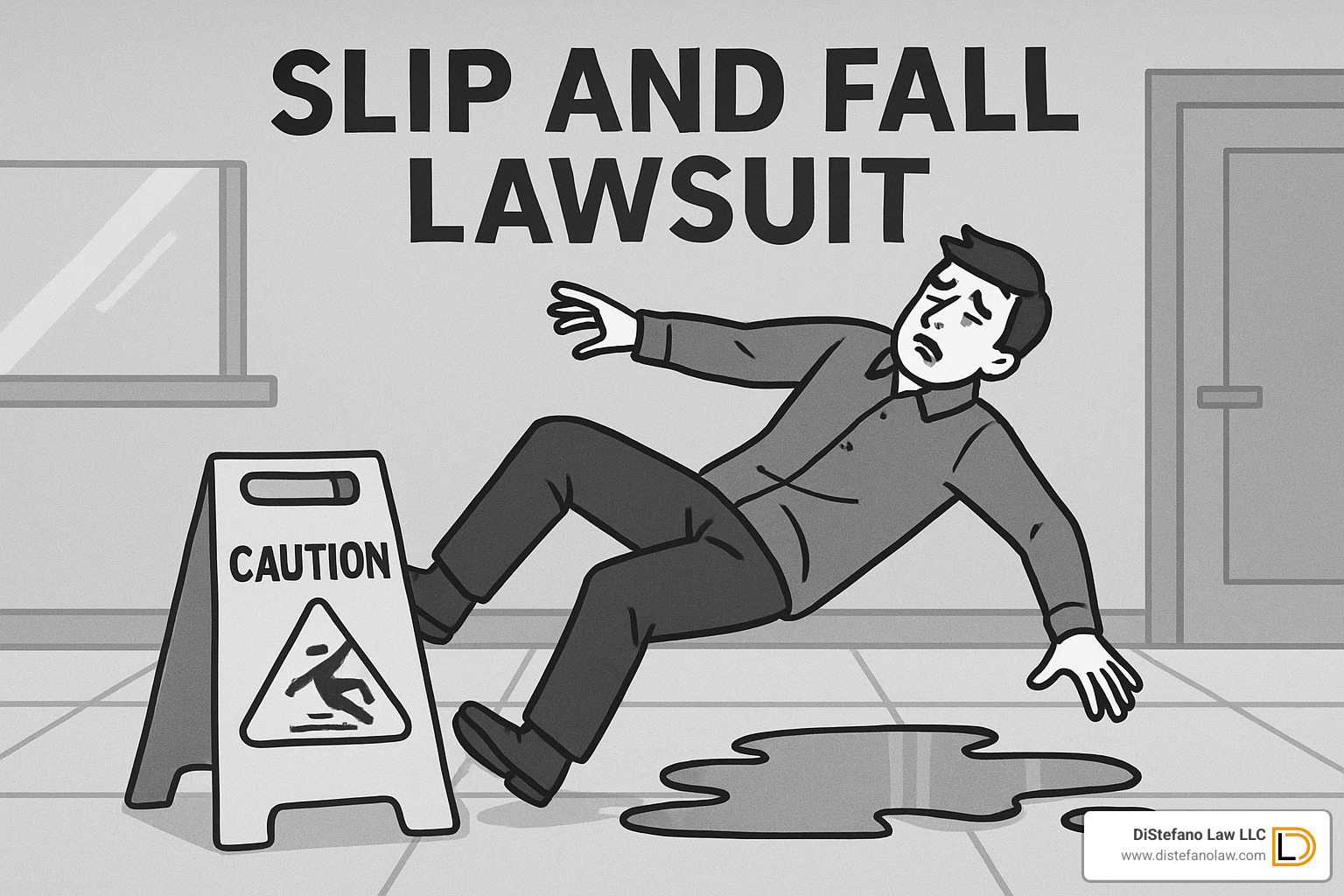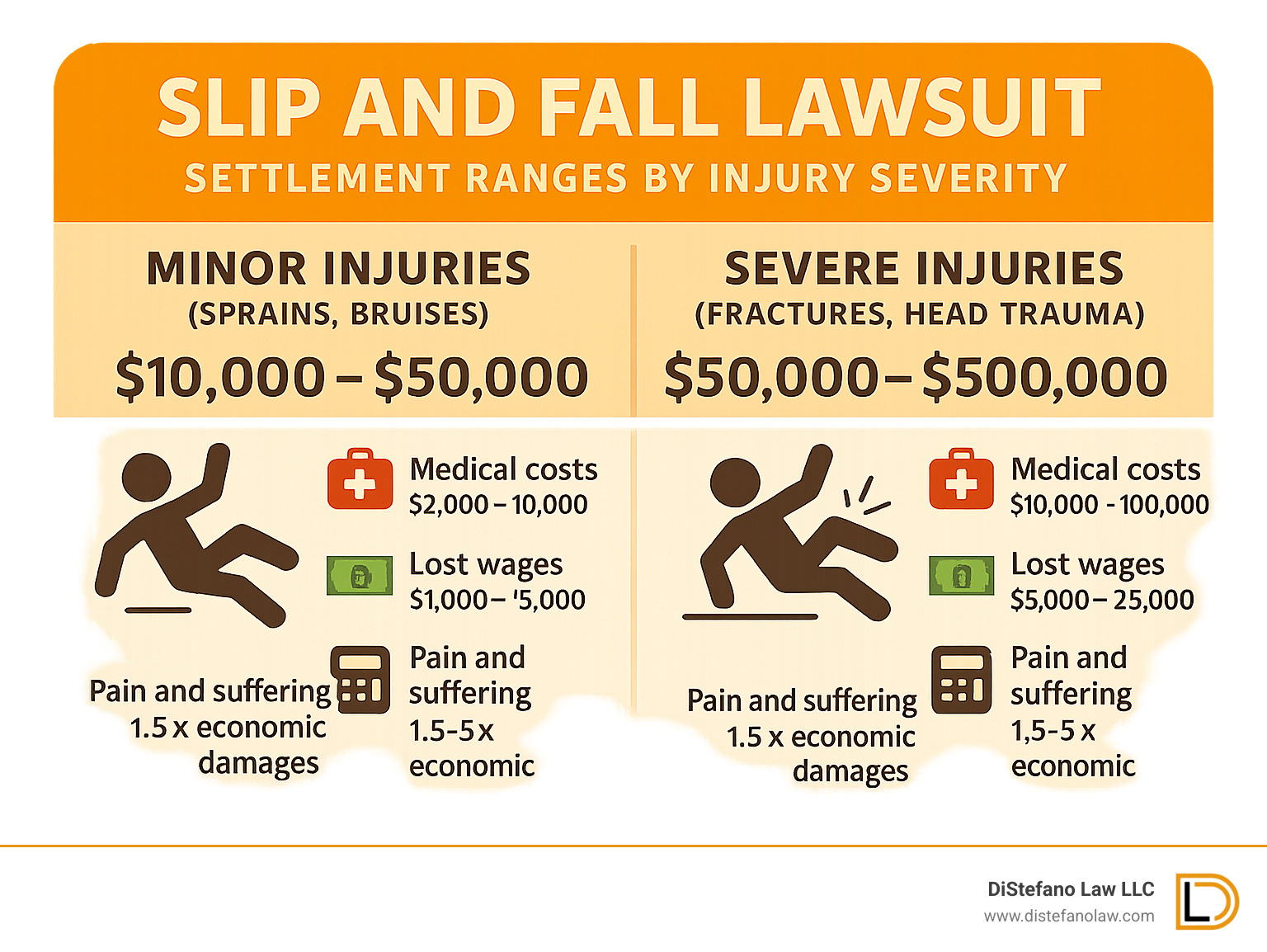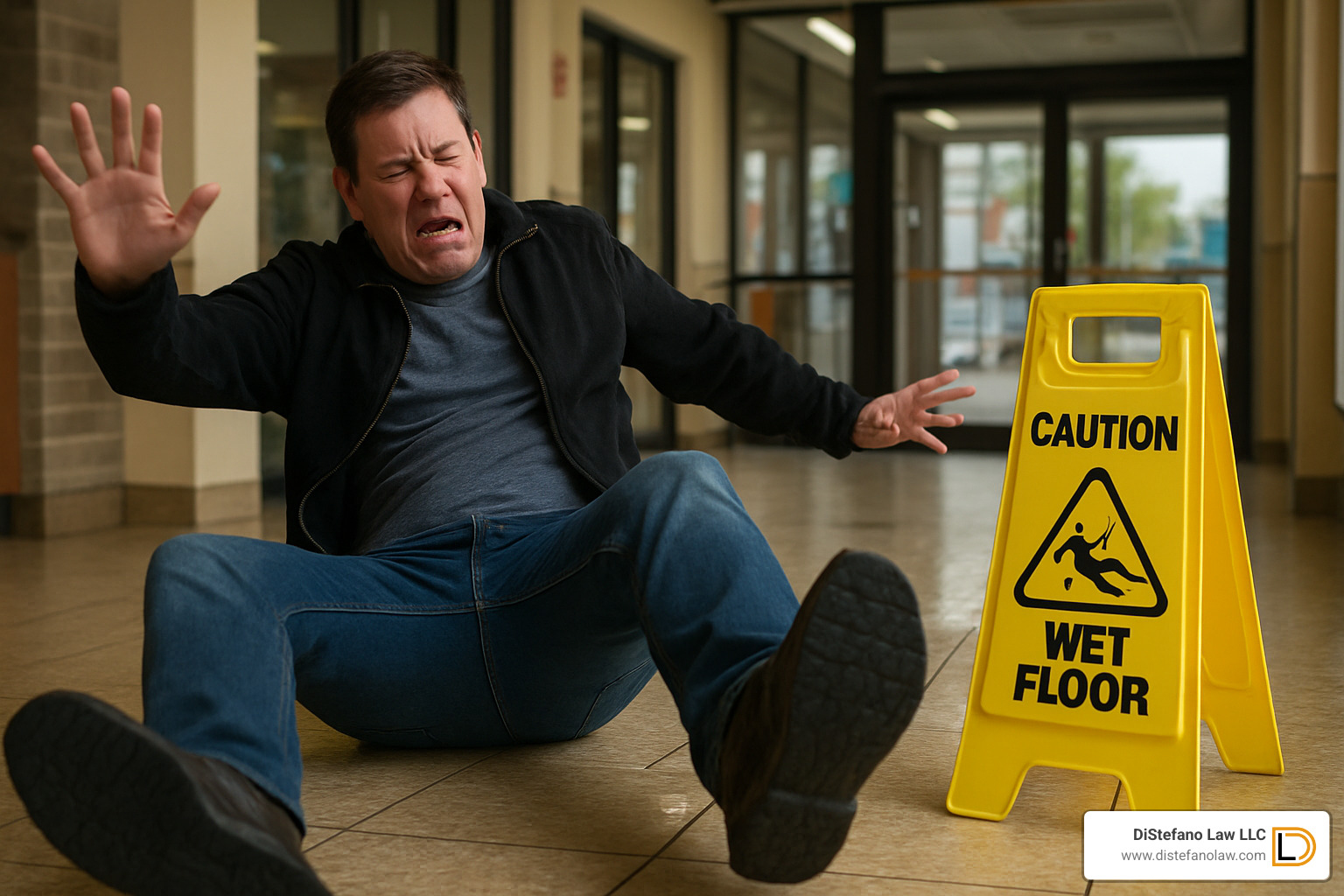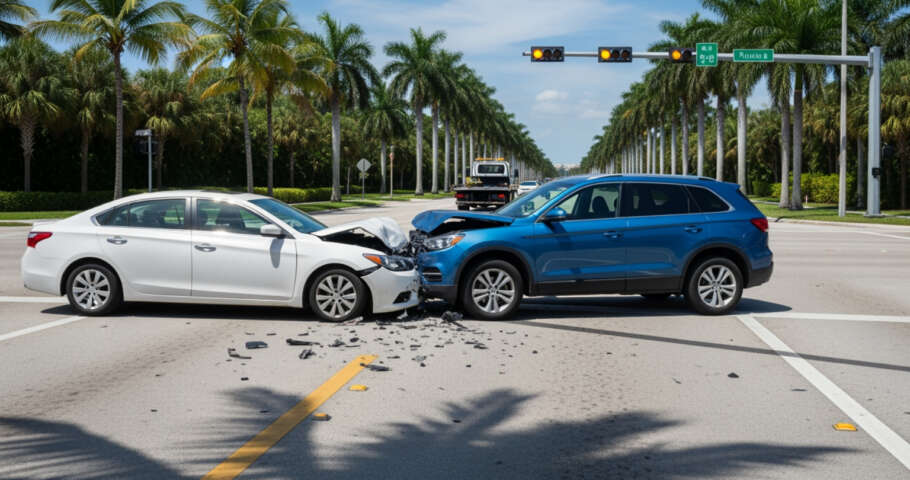Why Understanding Slip and Fall Lawsuits Matters
A slip and fall lawsuit is a legal claim filed when someone is injured due to hazardous conditions on another person’s property. Here’s what you need to know:
Key Elements of a Slip and Fall Lawsuit:
- Hazardous condition existed on the property
- Property owner knew or should have known about the danger
- Owner failed to fix the hazard or provide adequate warning
- Direct causation between the hazard and your injuries
- Actual damages from medical bills, lost wages, or pain and suffering
Timeline & Deadlines:
- 2 years to file lawsuit in Florida
- 10 days notice required for municipal property accidents
- 60 days notice required for private property ice/snow accidents
Every year, more than 42,000 Canadians are hurt in slip and fall accidents, with falls being the leading cause of death by injury in adults over 65. About 97% of civil cases settle without going to trial.
At DiStefano Law LLC, we’ve spent over 40 years helping Fort Lauderdale residents steer slip and fall lawsuit claims and secure millions in settlements and verdicts.

Quick Slip and fall lawsuit terms:
Understanding a Slip and Fall Lawsuit
When you’re injured in a fall on someone else’s property, you’re entering premises liability law. A slip and fall lawsuit is your way of holding a property owner accountable when their negligence leads to your injury.
Property owners have a legal duty to keep their spaces reasonably safe for visitors. When they fail and someone gets hurt, the law provides compensation through premises liability claims.
Your Legal Status Matters
Not all visitors are treated equally. Invitees (customers in stores) get the highest protection. Licensees (social visitors) receive moderate protection. Trespassers get minimal protection, with exceptions for children.
Common hazardous conditions include wet floors without warning signs, uneven surfaces, poor lighting, ice accumulation, debris blocking paths, and defective handrails.
Public vs. Private Property
Where you fell impacts your case timeline. Private property ice/snow accidents require written notice within 60 days. Municipal property accidents need notice within just 10 days. Miss these deadlines, and your case could be over.
Understanding Fault Division
Florida follows pure comparative negligence. Even if you bear some responsibility, you can still recover compensation reduced by your percentage of fault. If you’re 20% responsible for a $100,000 award, you’d receive $80,000.
Scientific research on occupational slips shows most falls result from multiple factors, making Florida’s approach realistic and fair.
Common Defense Tactics
Property owners typically argue the hazard was “open and obvious,” they had no constructive notice of the condition, plaintiff fault existed, or use timing defenses claiming insufficient time to address the hazard.
What Makes a Slip and Fall Lawsuit Viable?
Slip and fall lawsuits require four essential elements:
- A genuine hazard existed – substantial water accumulation, significant elevation changes, or structural defects
- Owner’s knowledge – actual or constructive knowledge through reasonable inspection
- Direct causation – the hazard directly caused your fall and injuries
- Documented damages – medical bills, lost wages, pain and suffering
Key Players Who May Be Liable
Property owners bear primary responsibility. Tenants may share liability for their leased areas. Maintenance contractors can be liable for negligent work. Municipalities face liability for public property accidents with special notice requirements. Snow removal crews may be liable for creating hazardous conditions.
What to Do Immediately After a Fall

The moments after you slip and fall could make or break your slip and fall lawsuit.
Get medical attention immediately, even if you feel okay. Your body’s trauma response can mask serious injuries.
Report the accident to the property owner, manager, or staff. Request an accident report and get a copy.
Document everything with your smartphone:
- The exact spot where you fell
- What caused your fall
- Your injuries
- Lighting conditions
- The surrounding area
- Any warning signs (or lack thereof)
Get witness contact information. Independent witnesses can support your case.
Preserve your clothing and shoes – they may contain important evidence.
Request surveillance footage preservation immediately, as many businesses delete footage within days.
Critical deadlines:
- 10 days for municipal property notice
- 60 days for private property ice/snow notice
- 2 years to file your lawsuit in Florida
For detailed guidance, check our slip and falls page.
Crucial Evidence That Can Win Your Case
Photos and videos often become star witnesses. Medical records must connect your injuries to the fall. Expert witnesses explain safety standards and injury causation. Security footage can be the smoking gun. Weather reports support claims about dangerous outdoor conditions.
The Slip and Fall Lawsuit Process & Deadlines
A slip and fall lawsuit follows a predictable path, typically taking months to years to complete.
Early Phase: Notice and Investigation
The first 60 days are crucial for providing written notice. Insurance adjusters investigate while you focus on medical treatment and evidence gathering.
Settlement Negotiations
Most time is spent negotiating. Insurance companies rarely offer fair compensation initially. Experienced legal representation makes a huge difference in these negotiations.
Filing the Lawsuit
If negotiations fail, we file within Florida’s 2-year statute of limitations. This often motivates better settlement offers, as 97% of civil cases settle without trial.
Findy Phase
Both sides exchange information and evidence. We request maintenance records while defendants may request your medical records and deposition.
Mediation
Courts often require mediation, where cases frequently settle with a neutral mediator’s help.
For comprehensive information, visit our Premises Liability services page.
Critical Deadlines
The Two-Year Rule: Florida gives you two years from your accident date to file suit. Exceptions exist for minors and mental incapacity cases.
Notice Requirements: Municipal property accidents require 10 days written notice. Private property ice/snow accidents need 60 days notice. These deadlines are unforgiving.
Common Defenses and Counters
Insurance companies use predictable defenses:
“It Was Obvious” – We counter by showing that reasonable safety measures could have prevented the accident.
“We Didn’t Know” – We examine inspection procedures and maintenance logs to prove constructive notice.
“You Caused Your Fall” – We minimize your fault while emphasizing the property owner’s primary negligence.
“No Time to Clean Up” – We investigate the timeline to prove hazards existed longer than claimed.
Damages, Settlement Math & Chances of Success

Slip and fall lawsuit compensation includes economic damages (medical bills, lost wages, property damage) and non-economic damages (pain, suffering, emotional distress). Punitive damages rarely apply unless conduct was outrageous.
Settlement ranges vary by injury severity:
- Minor injuries: $10,000-$50,000
- Moderate injuries: $50,000-$250,000
- Severe injuries: $250,000-$1+ million

Florida’s pure comparative negligence means you can recover compensation even if partially at fault, with awards reduced by your fault percentage.
Timeline Factors
Medical treatment drives timing – doctors need to reach “maximum medical improvement.” Investigation takes time when done properly. Court backlogs and insurance tactics can extend timelines. Multiple defendants complicate negotiations.
Settlement Calculations
We often use the multiplier method: total economic damages multiplied by 1.5-5 depending on injury severity. For example, $35,500 in economic damages with a 3x multiplier equals $106,500 in pain and suffering, totaling $142,000.
Factors influencing multipliers: evidence strength, injury permanence, age, credibility. Pain diaries documenting daily impacts strengthen non-economic claims.
For detailed compensation information, visit our Slip and Fall Compensation page.
Frequently Asked Questions about Slip and Fall Lawsuits
Let’s address the most common questions we hear from clients about slip and fall lawsuits. Understanding these key issues can help you make informed decisions about your case.
What is the statute of limitations for a slip and fall lawsuit in Florida or Ontario?
Time limits are absolutely critical in slip and fall lawsuits, and missing these deadlines can destroy even the strongest case.
In Florida, you have 2 years from your accident date to file your lawsuit. This might seem like plenty of time, but it goes by quickly when you’re dealing with medical treatment, insurance companies, and gathering evidence.
Special notice requirements make things more complicated. If you fell on municipal property like a city sidewalk or government building, you must provide written notice within just 10 days. That’s right—10 days, not months. For private property accidents involving ice or snow, some jurisdictions require 60 days’ notice to the property owner.
Ontario follows similar rules with a 2-year limitation period from when you knew or should have known about your injuries. The same tight notice requirements apply: 10 days for municipal property and 60 days for private property ice and snow claims.
Important exceptions can extend these deadlines. If you were a minor when injured, the clock might not start until you turn 18. Mental incapacity can pause the limitation period. In rare cases, the “delayed findy” rule applies when injuries aren’t immediately apparent.
Here’s the bottom line: don’t wait to seek legal advice. We’ve seen too many valid cases lost simply because someone missed a deadline they didn’t know existed.
Will my slip and fall lawsuit settle or go to trial?
The good news is that 97% of civil cases settle without going to trial. This means your slip and fall lawsuit will most likely resolve through negotiation rather than a courtroom battle.
Several factors make settlement more likely: when you have clear evidence of the property owner’s negligence, reasonable insurance policy limits that can cover your damages, and cooperative insurance adjusters who recognize liability. Strong legal representation also encourages fair settlement offers.
Some cases are more likely to go to trial. This happens when liability is disputed, insurance companies act in bad faith, or when catastrophic injuries exceed available insurance coverage. Sometimes insurance companies make unreasonably low offers, forcing us to let a jury decide fair compensation.
Settlement offers several advantages: you get your money faster, avoid the stress and uncertainty of trial, and keep your case private. Legal costs are typically lower, and you have certainty about the outcome.
Trial can be beneficial when insurance companies won’t offer fair compensation. Juries often award more than initial settlement offers, especially when they see how the accident has impacted your life. Trials also hold negligent property owners publicly accountable.
At DiStefano Law LLC, we prepare every case for trial while actively pursuing fair settlement. This approach gives us leverage in negotiations and ensures we’re ready if trial becomes necessary.
How does contributory or comparative negligence affect a slip and fall lawsuit?
Florida uses a “pure comparative negligence” system, which is actually good news for injured people. This means you can recover compensation even if you were partially at fault for your accident.
Here’s how it works: if you’re found 10% at fault, you still recover 90% of your damages. If you’re 50% at fault, you get 50% of your award. Even if you’re 90% at fault, you can still recover 10% of your damages. This is much more favorable than some states where any fault on your part bars recovery completely.
Insurance companies love to blame victims. They’ll argue you weren’t watching where you walked, wore inappropriate shoes, were distracted by your phone, or ignored warning signs. Sometimes they’ll claim you were intoxicated or impaired.
We know how to counter these arguments. We demonstrate that the property owner’s negligence was the primary cause of your accident. Even distracted pedestrians deserve safe walking conditions. We often prove that warnings were inadequate, missing, or that the hazard was unavoidable regardless of how carefully you were walking.
The key is having experienced legal representation that understands how to minimize your percentage of fault while maximizing the property owner’s responsibility. Small differences in fault percentages can mean thousands of dollars in your final compensation.
At DiStefano Law LLC, we’ve spent over 40 years protecting our clients from unfair blame tactics. We know how to present your case in the most favorable light while building strong evidence of property owner negligence.
Conclusion
Taking on a slip and fall lawsuit might seem daunting, but you have rights and can secure deserved compensation with the right approach.
Time works against you. Security footage gets deleted, witnesses move away, and legal deadlines don’t wait. Evidence is most powerful right after your accident.
Documentation is everything in slip and fall lawsuits. Insurance companies can argue with memory but not clear photographs showing what caused your fall.
Insurance companies employ teams whose job is paying you as little as possible. Professional legal help levels the playing field. Most clients are relieved learning 97% of slip and fall cases settle without courtroom trials.
At DiStefano Law LLC, we’ve helped Fort Lauderdale families for over four decades. We’ve seen how falls turn lives upside down – missed work, mounting bills, insurance company frustrations.
Starting today: Keep photographing healing injuries. Save every medical bill. Document how injuries affect daily life – these details matter enormously.
Don’t handle insurance companies alone. That friendly adjuster isn’t your friend – they’re trained to get statements that hurt your case.
We work on contingency fees – you don’t pay unless we recover money for your injuries. There’s no risk getting experienced legal help, but enormous risk going alone.
Contact us today for your free consultation. We serve clients throughout South Florida, including Lauderhill, Wilton Manors, and Sunrise.
Every day you wait is another day for crucial evidence to disappear. Don’t let this accident define your life. Let DiStefano Law LLC help you fight for deserved compensation so you can focus on getting better.
Stay safe, stay informed, and know we’re here when you need us most.




